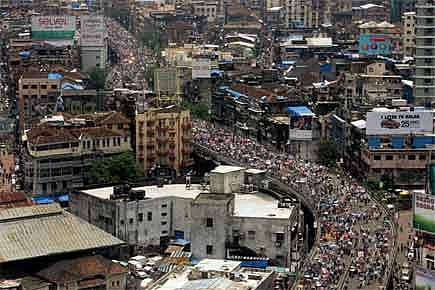Hypocrisy Over Housing

Houses for former mill workers on mill land is a popular election issue. Why do politicians keep raising it even though the workers themselves have moved on?
MUMBAI ~ Thirty years ago, when thousands of textile mill workers across the city walked in unison behind union leader Datta Samant, it was for the promise of a better life. Higher wages, regulated working hours and dreams of a happier future spurred them on to strike work, which remains noteworthy not just because of the number of days it went on for but also the manner in which it destroyed the fabric of the city. The strike more or less ruined the dream of a better life. Under its prolonged spell, money became a scarce commodity, depression (both psychological and economic) gripped large parts of the city, and many homes broke up.
A week ago, on the 30th anniversary of that strike, few mill workers wanted to remember those days. However, the city's politicians would not let them forget it. With the Brihanmumbai Municipal Corporation, one of the largest civic bodies in the country, going to polls in mid-February, the 'struggle' of mill workers has acquired a renewed focus.
Only a few mills are left in the city, and these too have shut down. Swanky malls have replaced the rest. The area stretching from Parel in Central Mumbai to Girgaum in South Mumbai—formerly known as Girangaon, thanks to the concentration of textile mills here—is now among the priciest tracts of real estate in the city. Even a crore is not enough to buy a two-bedroom flat in this area.
Mill workers have also moved on with their lives. Not only do they often hang out in those malls, their children have found jobs in the high-end shopping archades that stand on mill land, and take home decent salaries. There is a whole new energy to the place. But every now and then, vote-hungry politicians rake up the past, pretending that they still care for mill workers' woes.
The Girni Kamgar Sangarsh Samiti continues to organise morchas (protests) demanding housing for the 250,000 odd workers who were once employed by these mills. The Maharashtra government, specifically the earlier Shiv Sena-BJP regime, had even announced that if mills were to be developed as commercial properties, a portion of the land had to be used to house former mill workers and their families. The policy, however, remains only on paper. Neither did the saffron government push hard to implement it, nor did the dispensation that followed. What did happen was that when mill owners were unable to commercially develop a mill that had been shut down—as a result of pressures of workers' demands—mysterious fires began to engulf the defunct mills. Though the police and fire brigade investigated these incidents, no culprits were caught. A few months later, a sprawling mall or swanky office complex would come up on the land of the burnt-down mill.
The coffers of local politicians swelled, and many became partners in developing mill land. Interestingly, Shiv Sena leader and former Lok Sabha Speaker Manohar Joshi, as also the president of the Maharashtra Navnirman Sena Raj Thackeray, bought mill land with the intention of building swanky malls. Though they have never implemented the policy of building homes for former workers on these estates, they are now at the forefront of protests demanding housing for them. Incidentally, the housing policy for mill workers was put in place when Joshi was the state's Chief Minister.
As campaigning for the 227 wards of the BMC gets underway, rehabilitating former mill workers is being raised as an issue by the Shiv Sena, MNS, BJP, Congress and also the NCP. The Shiv Sena-BJP combine—which has controlled the BMC for 17 years—has been a votary of high-end commercial development on mill estates. Before the elections were declared, they had even signed on the dotted line to erect more malls. So how do they intend to house these former mill workers?
The other question is: do former mill workers want to live on mill land? "We lived in chawls where we did not pay any maintenance fee. The maintenance for even a one-room flat is too high. Real estate prices have increased due to malls, so even if houses are built for us, how do we pay such high maintenance?" asks Hanumant Sawant, a former mill worker.
Both mill workers and politicians know that it will be difficult to implement the housing policy, given the competitive commercial development of former mill estates.
